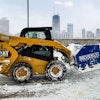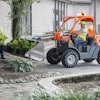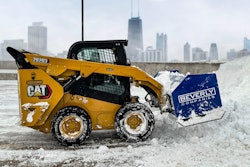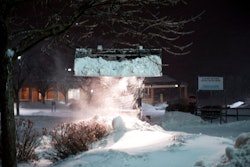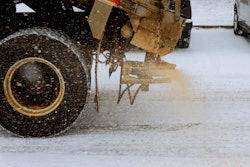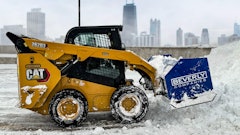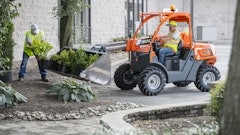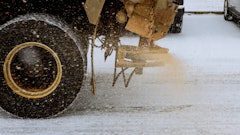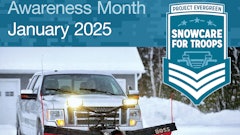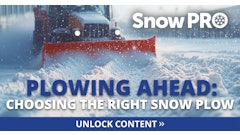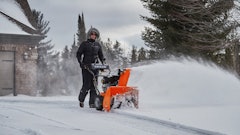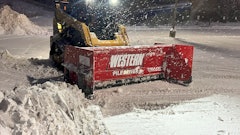
Snow contractors understand that time is money, and the right equipment can make all the difference. Homeowners and property managers want faster service, reliable results, and the ability to handle bigger storms.
If your current equipment can’t keep up with those demands, it may be time to consider upgrading to a setup that meets your growing needs.
Focusing on multiple properties within the same neighborhood or community can streamline your routes and save valuable time. When sites share similar layouts, like parking lots, alleys, or shared driveways, plow drivers can minimize downtime between locations and plan material placement more efficiently.
If you’re ready for the next step of growth, focus on getting more efficient with your equipment. Whether you’re in residential or commercial work, upgrading your snow removal equipment can increase your profitability without adding manpower.
If the driveways or properties on your route are simple and straight, you can easily use a straight blade and clear them out in no time. If there are more curves, carports, or varying geometrical shapes, the versatility of a v-plow or winged plow could help you get the job done more efficiently.
Signs That You’ve Outgrown Your Plow
There will come a time when you simply can’t rely on your current setup any longer to get the job done. Added business growth and new commercial properties require constant upkeep that can cause used equipment to break down to the point where maintenance becomes more costly than the equipment is worth. When this happens, it’s time to consider upgrading to a more heavy-duty setup.
Having the right tool for the job will ensure you don’t run the risk of abusing your equipment. A light-duty plow will not perform the same or hold up as well as a heavy-duty plow that is designed to withstand substantial wear and tear. You also need to carefully consider the size of the vehicle you are using to handle the additional weight. As you upgrade your plow and the weight increases, your vehicle must also level up.
Making the Move to V-Plows
If you’re currently using a straight blade on a half-ton, a good next step may be upgrading to a newer 3/4-ton truck with a v-plow setup. Often called the “Swiss Army knife” of snow removal, v-plows provide added versatility in a variety of conditions, from breaking open deep drifts to pushing larger volumes of snow.
A v-plow also offers advantages when working in tighter spaces or handling residential driveways, thanks to their ability to angle, scoop, or back-drag more effectively than a straight blade.
For contractors covering multiple sites, that flexibility often translates into noticeable efficiency gains. Operators have reported cutting their route times by up to 25 percent by utilizing a v-plow set up, depending on property layout and route density.
Nothing Like Winged Plow Efficiency
A second option to consider is upgrading to the ultimate truck plow — a winged snowplow on a 1-ton truck. There is a higher cost and learning curve up front, but the decision to upgrade equipment in this manner can certainly pay off in the long run. Contractors can see efficiency gains up to 30 percent by adding a 1-ton truck with a wing plow into their fleet, compared to a 3/4-ton truck with a v-plow.
TIP: If you’re not in the position to buy a new winged plow but want to increase your snow carrying capacity, consider adding wings to your straight blade. It still requires a larger truck, but can be a quick and affordable solution that will help you gain some efficiency in your setup.
Buying Used Vs New
Most entry-level plow drivers start with a used straight blade or v-plow on a truck. Although new equipment is more dependable, it can come at a higher price point and could slow down your ability to start making a profit. There is typically a large pool of used equipment available for entry-level plow drivers or contractors who are looking to expand and save money.
Added Benefits of Investing in Good Equipment
Most large contractors are always looking for subcontractors to provide snow and ice services to properties outside their self-performing territory. These subcontracting opportunities can require access or ownership to specific equipment to ensure the promised service levels can be provided. By investing in new and versatile equipment, you’ll better position yourself for these opportunities.
Slowly Add in Salting Services
Salting or de-icing services allow your operation to diversify. Even if there is only a chance of snow in the forecast, your operation can pre-treat during normal hours in advance of the storm for a billable service. Adding this service to your offerings can really boost profit margins and keep you busy in the winter.
If you have a few small requests, a walk-behind broadcast or drop spreader is the perfect way to add onto your services without getting in over your head with equipment expenses early on. Then, make the transition to a tailgate or hopper when the time is right.
Start out with store-bought, bagged materials as needed. As you grow your de-icing services, you can buy pallets of bagged material or upgrade to a bulk salt pile. Just remember to start thinking about placing orders early in the season, well before demand depletes supply.
Incorporating pre-wet and direct-liquid capabilities to your ice control services is another excellent way to broaden your reach. It can increase efficiency by “activating” salt to accelerate ice melting ability. Pre-wetting your salt reduces scatter, keeping on paved surfaces where it can work to melt ice or prevent ice from forming.
Making Your Way into Commercial Services
If you have mostly residential accounts but are interested in generating more revenue, start by adding one or two commercial properties. By investing your time in fewer, more lucrative accounts, you could expand your revenue without expanding your workforce.
Commercial accounts are paying for peace of mind knowing that their customers and employees are safe, resulting in less liability risk. Commercial accounts are more demanding and may need you to service the property multiple times throughout a storm, but they are willing to pay for it.
Knowing When to Add Extra Manpower
Keep in mind that the more commercial accounts you maintain, the more “on call” you will be. At a certain point, you will need additional help. The first team member might function as your “sidewalk crew,” where there is less equipment overhead needed.
Pace yourself and be realistic with your needs. As your commercial property demands increase, you’ll need to adjust your strategy and potentially invest in more equipment to keep up. Once you add employees, you become responsible for someone else’s livelihood, so make sure you can maintain enough work to keep you both busy.
Preparing for the Worst
The key to being a profitable snow and ice contractor is being prepared for the absolute worst. The last thing you want is to have a detrimental breakdown in the middle of a huge storm, especially as a one-person operation. Having a backup plan will help keep things running smoothly.
- An emergency field repair kit is crucial. It will allow you to have all key tools and parts in case you experience a breakdown in the field. This is especially important as a single operator.
- Having a backup vehicle is also ideal. Although it’s not always financially possible, winters are harsh and there will come a time where you can’t make a repair as fast as you need to. Having the option to set it aside and jump into your backup to finish out the storm can save you a ton of headaches and phone calls from angry clients.
TIP: Having a UTV, skid-steer, or tractor as a backup vehicle is a wise investment and could also transition to landscape use in the spring and summer months.
One Step at a Time
Everything in this business is based on relationships and takes practice and experience over time. As you grow, don’t forget the fundamentals — be punctual, consistent, and courteous. Remember, word-of-mouth travels very fast in this line of work, so do your due diligence to keep a positive reputation.
Growing your business is a balancing act. Move forward when you feel confident, and remember it’s ok to pause when you need to. The goal is maintaining steady, sustainable progress by increasing your bottom line, staying in control of the work you do, and owning the quality you deliver.

